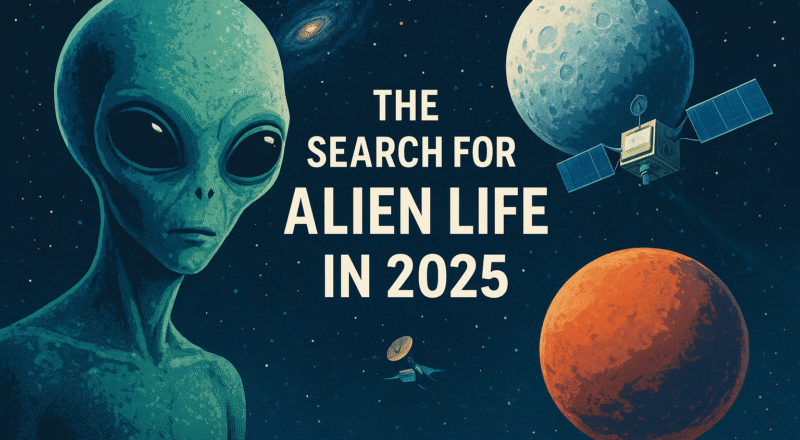🌌 Introduction: Humanity’s Biggest Question
For centuries, humans have looked up at the stars and wondered: Are we alone in the universe?
That question isn’t just philosophical anymore—it’s becoming a scientific pursuit with real-world funding, technology, and international collaboration. In 2025, the search for extraterrestrial life has moved from speculative fiction to a global, multi-billion-dollar effort powered by NASA, private companies, and cutting-edge AI.
From Europa’s hidden oceans to exoplanets light-years away, humanity’s quest for alien life is no longer “if,” but “when.” And 2025 might just be the year that brings us closer than ever before.
🚀 NASA’s Missions Leading the Search
Europa Clipper: Unlocking the Icy Moon’s Secrets
Set for launch in late 2025, NASA’s Europa Clipper is one of the most ambitious missions in history. Its goal? Explore Jupiter’s icy moon Europa, widely believed to have a subsurface ocean beneath its thick crust of ice.
-
Scientists suspect this ocean could contain more water than Earth’s oceans combined.
-
Hydrothermal vents on the seafloor may provide the perfect conditions for microbial life.
-
Europa’s surface chemistry, captured by Clipper’s instruments, could reveal biosignatures—chemical hints of life.
If Europa harbors even simple microbes, it would be the first confirmed discovery of alien life within our solar system.
James Webb Space Telescope (JWST): Scanning Alien Atmospheres
The JWST continues to dominate astronomy headlines. In 2025, it has turned its focus to exoplanet atmospheres—specifically those within the “habitable zone.”
JWST has already detected water vapor, methane, and carbon dioxide in distant planets’ skies. These molecules are potential indicators of life, especially when combined in unusual ratios.
In 2025, astronomers are zeroing in on exoplanets like:
-
TRAPPIST-1e and TRAPPIST-1f — rocky worlds that may have liquid water.
-
Kepler-452b — sometimes dubbed “Earth 2.0.”
-
K2-18b — showing hints of hydrogen-rich atmospheres.
Every new atmospheric reading brings us closer to answering whether life exists outside Earth.
📡 SETI, AI, and the Next Era of Signal Hunting
The Search for Extraterrestrial Intelligence (SETI) has been running for decades, scanning the skies for radio signals. But now, SETI has supercharged its mission with artificial intelligence.
-
AI algorithms process billions of radio signals per second, filtering out human-made noise.
-
In 2025, SETI collaborates with cloud computing giants like Google Cloud and AWS, making signal detection faster than ever.
-
Some of the most promising signals come from M-dwarf stars, small red suns where exoplanets are more detectable.
So far, no “Wow! signal” has been confirmed as alien—but the tools to catch one have never been sharper.
🧬 Astrobiology: Life on Earth’s Extremes as a Model
To understand alien life, scientists first study Earth’s most extreme environments:
-
Hydrothermal vents in the Mariana Trench host ecosystems without sunlight.
-
Antarctic lakes contain microbes that thrive under permanent ice sheets.
-
Desert crusts survive on minimal moisture, hinting at how life might endure on Mars.
Each new extremophile discovery makes the possibility of life beyond Earth more realistic than ever. If microbes thrive in boiling acid, freezing glaciers, or crushing deep-sea pressures—why not under Europa’s ice or on Mars’ ancient riverbeds?
🚀 The Role of Private Space Companies
NASA isn’t alone in this race. Private companies are heavily investing in the search for alien life:
-
SpaceX: Elon Musk’s Starship aims to send humans to Mars. While colonization is the headline, Mars exploration also carries the potential to uncover ancient microbial fossils.
-
Blue Origin: Jeff Bezos envisions millions living in space, but his investments in lunar landers could also enable biosignature-hunting instruments to reach moons like Enceladus.
-
Rocket Lab: Smaller and more nimble, Rocket Lab is pioneering cost-efficient probes that could reach asteroids and moons faster than NASA’s large missions.
Together, these companies are turning extraterrestrial exploration from government-only programs into a multi-sector pursuit.
🔭 The Most Promising Worlds for Life
By 2025, scientists have narrowed down a handful of “prime suspects” in the search for alien life:
-
Europa (Jupiter’s Moon) — Subsurface ocean, potential hydrothermal activity.
-
Enceladus (Saturn’s Moon) — Geysers that shoot water vapor into space, already detected by Cassini.
-
Mars — Once had rivers, lakes, and possibly microbial ecosystems.
-
Titan (Saturn’s Moon) — Methane lakes and organic-rich chemistry.
-
Exoplanets in TRAPPIST-1 System — Seven Earth-sized planets, three in the habitable zone.
These locations are the frontlines of the alien life search.
⚖️ The Ethical and Cultural Questions
Finding alien life—whether microbial or intelligent—raises profound questions:
-
Religious Impact: How would major religions react to proof of extraterrestrial beings?
-
Political Power: Which nation or company controls access to alien worlds?
-
Human Identity: Would humanity see itself as part of a cosmic community—or feel threatened?
Philosophers argue that microbial life discovery would shift science but not society. Intelligent life, however, could rewrite civilization itself.
🔮 Looking Ahead: The Next Decade of Alien Life Search
If 2025 is the year of preparation, 2030 could be the year of discovery. By then:
-
Europa Clipper and other missions will have returned data.
-
Next-gen telescopes like the Nancy Grace Roman Space Telescope will identify more habitable exoplanets.
-
AI will scan millions of stars for alien signals in real time.
-
Private probes could touch down on Enceladus and Titan.
Some scientists believe microbial life will be confirmed within 20 years. Intelligent life, however, may take centuries—or may already be watching us.
🌠 Conclusion: Closer Than Ever
The search for alien life in 2025 is no longer science fiction. With NASA’s deep-space missions, private rocket companies, AI-powered signal detection, and breakthroughs in astrobiology, humanity stands on the edge of one of the greatest discoveries in history.
Whether it’s microbes on Europa or radio signals from a distant star, the truth is out there—closer than ever before.
